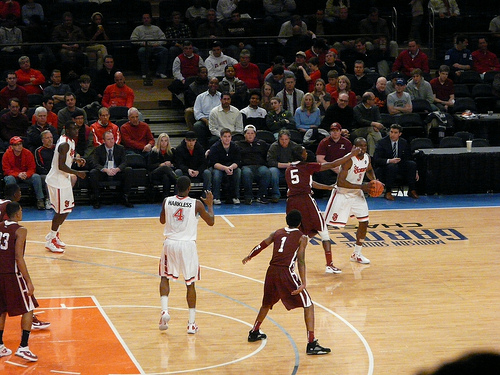Common Problems seen when Passing to a Cutter

Passing to a Cutter in the half court is really one of the least focused on activities during training sessions. It is however, the most fundamental of techniques in generating and executing offense. Without the ability to pass to cutters every team’s offense would be slow, one dimensional and lack the ability to perform regularly. Most players develop the ability of passing to a cutter through trial and error and often rely more on their “gut feeling” rather than a sound understanding of when to push a pass and when to hold off instead.
There are a great deal of problems commonly seen when layers are passing to a cutter during games. Below are just five key areas to be aware of and to share with players so they can self-coach to a better performance on the court.

Poor Offensive Awareness
In the context of passing to a cutter, offensive awareness comes from understanding the team’s offense and knowing where the breakdowns are likely to happen for the opposition. If a player is not comfortable with a team’s strategy, plays or counters. Then they doom themselves to always being reactive, rather than proactive. This will see an offense become slower, not always find the right player, and ultimately hamper productivity. Players must understand where the space is within an offense so they can exploit this to the advantage of their teammates.
Not Engaging the on Ball Defender
Many players when they are looking for a passing to a cutter opportunity will shut off to what is happening directly in front of them with regards to their own defender. Players stop looking to engage their own defender and create a situation where five defenders are now playing against four offensive targets, instead of playing against the ball. How many times have you seen a player pick the ball up off a dribble and put the ball above their head looking for a passing target? This completely stifles an offense.
Players need to constantly engage their defensive match-up. When seeing a passing opportunity unfolding a quick fake (pass, shot or jab) can shift a defender, opening a bigger passing lane, but also still forcing this player to stick with their match-up instead of just falling into a help position.
Choose the Wrong Pass
The correct passing technique is as much a part of passing to a cutter as any other element. All variations of a pass have their place within an offense. Choosing the right one will help the passer in executing a good pass and the cutter in receiving this. A Bounce Pass for example when the cutter is under extreme pressure, moving at a high pace, will often make the challenge of securing the ball harder and increase the chances of a steal occurring. Alternatively, utilising a Push or Overhead pass may provide the best solution for putting the ball in front of the cutter.
Vision
Initially, good vision when passing to a cutter starts with the passer. Seeing space as the offense unfolds allows for good options to be seen and taken advantage of. This requires a player to be facing the basket with their head on a swivel looking for all the opportunities in time and sequence.
The receiver of a pass also must maintain vision or risk not seeing the ball during the initial stages of the passing opportunity. Very few players have the ability through quick reaction to catch a pass without early vision of the ball as it is being released, not as it is in flight.
Target Area
When cutting to the basket an offensive player must provide a target for their teammates. This can be completed by simply carrying the hands in the position the player would like the intended pass to be made to. Carrying hands allows for a quicker reaction and increases the margin of error if a poor pass occurs. Having hands at the ready makes everyone look better.
When looking at passing to a cutter the ball handler to should look to where the player is moving and not where they have been. Passing at the player is one of the most common misconceptions about where the target area is, from a passers point of view. Instead, a passer should look pass out in front of the cutter so as they reach the intended point of receiving the pass, the catch is made within an arm’s length away from the cutters body.
Passing to a cutter is a challenging activity. As players move up in age and ability games become faster, margins of error become smaller and passing opportunities present themselves for shorter periods of time within each phase of an offense. Helping players understand causes of some of the problems highlighted above will save much frustration later on the court.





